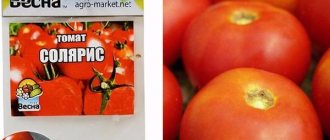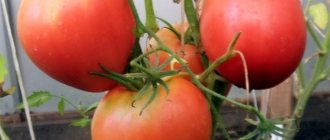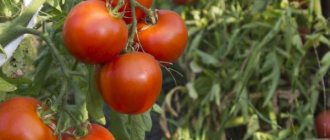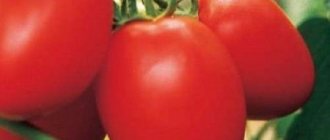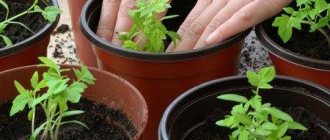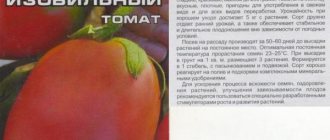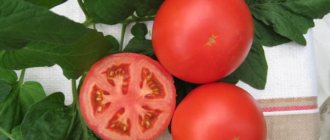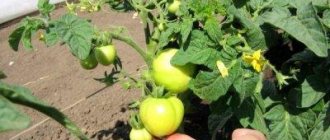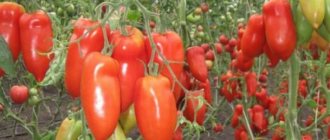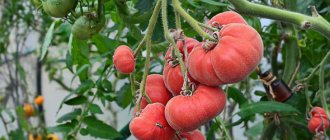Tomato Admiralteysky: characteristics and description of the breeding variety with photos
The Admiralteysky tomato can grow in unfavorable climatic conditions in open ground. Gardeners receive their first harvest in early July, and the harvesting season ends completely by mid-August. The described tomato variety was created by breeders from St. Petersburg.
Some information about the plant and its fruits
Characteristics and description of the Admiralteysky variety:
- The growing season of a tomato lasts from 85 to 97 days. It can be grown in open ground, under film coverings, in greenhouses made of any non-woven materials.
- The bushes of the plant reach a height of 0.6-0.7 m. You need to know that this tomato is prone to the formation of a large amount of leafy mass. The leaves on the bushes are small, painted in dark shades of green. There are small gaps between the leaf plates. Leaves appear in 2 waves.
- Admiralteysky tomatoes resist late blight well and do not suffer from gray rot or cladosporiosis.
- The fruits of this variety weigh from 0.2 to 0.21 kg. They are distinguished by dense pulp. Unripe berries are green, and ripe fruits are red.
- The tomato of this variety has a spherical shape, flattened at the stalk and in the upper part. Slight ribbing is noticeable on the berries.
- This type of tomato has a thick skin. They have a sweet taste with a little acid.
Reviews from gardeners indicate that the yield of the Admiralteysky variety reaches 7-8 kg/m². When breeding it, one must take into account the need to form a bush and fulfill all the requirements of agricultural technology, otherwise the harvest may be reduced by 25-30%.
“Admiralteysky” is used to create canapés and salads. The advantage of the variety is that tomatoes do not crack during heat treatment, and their pulp does not spread when cutting the fruit. The fruits of this variety are suitable for assorted canning, and can also be used to make high-quality juices and tomato paste.
How to plant “Admiralteysky” in a garden plot
To grow these tomatoes, seeds for seedlings must be sown no earlier than the last week of March. After the sprouts appear, the boxes with seedlings are placed in a cool room with good lighting. For sprouts, it is necessary to create daylight hours lasting from 16 to 18 hours. For these purposes, a special lamp is used. After 2 leaves appear, all seedlings dive.
This tomato does not like excessive moisture, so the volume of water for irrigation must be strictly regulated. After the sprouts reach a height of 7-8 cm, it is recommended to harden them. Young seedlings are transferred to permanent soil at an air temperature of 20⁰C, having previously added mineral fertilizers to the soil. For 1 sq. m of beds cannot be planted with more than 4-5 bushes.
Growing bushes need to be watered once every 2 weeks, but each bush requires up to 7 liters of warm water. When planting, plants are formed into 2 stems. It is imperative to remove the stepsons. Since the mass of fruits is quite large, it is recommended to tie the stems to strong supports.
Feeding the bushes with mineral complex fertilizers is carried out when the ovaries form and the berries ripen. The most commonly used are potassium nitrate and superphosphate. To prevent plants from producing too many leaves, you must strictly adhere to the schedule for using fertilizers.
If the fruits have begun to ripen, but climatic conditions are deteriorating (for example, a sharp cold snap is expected), then you can begin harvesting. For ripening, fruits must be placed in a dark pantry.
To eliminate the risk of disease development, it is recommended to treat tomatoes with drugs that destroy viruses and fungi. When garden pests appear, it is necessary to spray the leaves on the bushes with appropriate toxic substances that kill insects and their larvae.
What is good about the Admiralteysky tomato?
The Admiralteysky tomato variety was developed by St. Petersburg breeders. They set themselves the task of creating a vegetable crop that bears fruit well in places with short summers and low air temperatures. Their work was a complete success. Admiralteyskie tomatoes turned out to be very tasty and also ripen quickly. The first ripe fruits are harvested in July, and by mid-August the entire crop on the bushes is fully ripened.
Brief description of the variety
The tomato bears fruit well in the latitudes of the Leningrad region. Tomatoes are successfully grown in beds in open ground, in greenhouses or greenhouses. Harvesting begins one hundred days after planting the seeds for seedlings. There is one peculiarity in the ripening of the fruits of this variety. The first tomatoes ripen together, then there is a break in the ripening of the remaining fruits, after which they again ripen to the last.
The green mass on the bushes is very thick, and the bushes themselves do not exceed 70 centimeters in height. According to the description, the dark green leaves of this variety are small and flat, and they are located close to each other. If you do not form a bush, then the tomatoes on it will be small, so many gardeners reduce the number of stems to make the fruits larger. With careful care, up to 8 kg of vegetables can be harvested from one Admiralteysky f1 tomato bush.
Ask and receive useful advice from professional gardeners and experienced summer residents.>>
Thanks to their rapid ripening, Admiralty tomatoes do not have time to develop late blight. They are also not susceptible to gray rot and cladosporiosis.
Description of fruits
Traditionally, the tastiest tomatoes are those that take a long time to ripen. This does not apply to the Admiralteysky variety. These tomatoes have a rich, very pleasant taste. Their sweet and sour pulp is dense and juicy, as can be seen in the photograph. The fruits weigh on average from 200 to 210 grams, which corresponds to the characteristics.
When ripe, the skin of these tomatoes turns bright red. They are spherical in shape, slightly flattened, with barely noticeable ribbing. The peel is dense, which allows the fruits to be transported over long distances and stored fresh for a long time without refrigeration, which is confirmed by reviews from gardeners.
Admiralteysky tomatoes are equally tasty fresh and canned. They look delicious in the photo too. They make excellent ketchups and all kinds of dressings.
Features of cultivation
To obtain the highest possible yield of these tomatoes, you need to strictly follow some rules for caring for them. Only in this case will the fruits ripen early, be large and tasty.
Seeds for seedlings should be planted in the last week of March. There is no need to do this before. Before the first shoots appear, the container with seedlings should be kept warm and in good light. Then put it in a cool, bright place.
After forming two leaves on the sprouts, pick them into separate cups. The soil should always be just slightly moist. Excess moisture will certainly lead to the death of sprouts.
When the bushes grow seven centimeters, begin to harden them. To do this, take the cups out into the open air, increasing the time every day.
Transplant the seedlings into the beds when the daytime temperature reaches 20 degrees.
Feed the soil in the beds with complex mineral fertilizers.
The planting should not be dense. Plant no more than 5 bushes per square meter of soil.
Water Admiralteyskie tomatoes no more than once every two weeks, only at the root.
Pour at least 6-7 liters of water under each bush.
If you want to get large fruits, then leave only two stems on each bush, and then remove all the stepsons. Tie the bushes to reliable supports.
Top dressing
Apply complex mineral fertilizers to the soil for the first time before planting seedlings in the ground.
The second time this is also done using mineral fertilizers, when the ovaries appear on the bushes.
The third feeding is needed when the fruits begin to ripen. The soil is fertilized with potassium nitrate and superphosphate.
The rules for fertilizing and the dosage of fertilizers should be strictly observed. Excess of nutrients causes rapid growth of foliage to the detriment of fruit development.
If there is a threat of a strong long-term cold snap, tomatoes of the Admiralteysky variety can be harvested unripe. They will ripen in a dark pantry without losing their taste. It is not recommended to leave them in the light to ripen.
To prevent diseases or the appearance of harmful insects on the bushes, this variety is treated with appropriate folk or chemical means of protection.
Admiralteysky – variety of Tomato plant
Variety characteristics:
Properties of the Admiralteysky variety:
Recommended region on the map:
Information on the admission of Tomato Admiralteysky from the Register of the State Variety Commission of the Russian Federation
Application for admission No. 37052, registered 2001-09-19. The Admiralteysky Tomato variety was included in the register of those approved in 2002. Approved for use in regions: All regions.
The originator of the Admiralteysky Tomato variety is:
Other varieties of tomato plant
Search for variety by name
Variety selection
Question to the portal experts
If you haven't found the answer to a question, don't hesitate to ask an expert.
Register or Login so you don't have to enter your Name and Email every time
Thanks for the comment! It will be published after checking by a moderator!
No comments yet, be the first!
A portal for those who love their dacha
Your question has been sent for moderation. Don't worry, we quickly check your questions and your question will be answered within 1 day.
Description of the hybrid
Hybrid tomatoes are virtually guaranteed to be resistant to diseases and bad weather conditions, which is something that non-hybrid varieties suffer from. Greenhouses and greenhouses are valued for storing heat, but in them tomatoes can suffer from too high temperatures and sudden temperature changes. In recent years, world selection has been aimed at producing “heat-resistant” hybrids with a reliable guarantee of ovary production.
Hybrids are especially helpful in a greenhouse or a small garden plot where there are no real opportunities for crop rotation and diseases are prevalent. Selection successes demonstrate confident resistance to various types of infections - viral (especially the most dangerous tobacco mosaic virus), fungal, bacterial. In addition, the hybrids have uniform fruits and consistently high yields.
Tomato Incas F1
One of the best hybrids for canning whole fruits without skin. Popular early high-yielding bush hybrid. The plant is medium-sized, compact.
Tomato from the Dutch company Numens, zoned in Russia; entered into the state register in 2000. Mid-early hybrid (105 days) of meter-high vegetables, determinate. Very high resistance to fungal diseases has been recorded. The fruits are 80-100 g, dense, bright red, pepper-shaped, fleshy, uniform, tolerate sunburn well, are very easy to ripen, transported over long distances without loss of quality.
Tomato Torquay F1
Dutch hybrid from Bejo Zaden; in the Russian register since 2007. Mid-season tomato (119-123 days from germination to ripening), bush type - determinate, maximum height 100 cm. Forms abundant multiple clusters with fruits weighing 60-140 g. Dense tomatoes withstand long-term transportation, excellent in pickling and pickling matters.
Tomato Mariana F1
The tomato was created in the French branch of the Japanese company Sakata (the image of the woman Mariana is a symbol of the French Republic). The breeders of this agricultural company are often suspected of producing GMOs, but so far without real evidence. Mariana is a mid-early determinate hybrid. The fruits are similar in shape to Incas - also elongated-oval, perfectly smooth, super dense.
Tomato Bagheera F1
Hybrid from the leading French seed company Cloz. Included in the Russian seed register in 2007.
Early high-yielding hybrids are a real boon for the garden. They are cold-resistant, do not need pinching or tying up, and practically do not get sick. The ripening period is marked as medium-early; determinate bush. The fruit is round, flattened on top, ribbed, weight ranges from 80-220 g. The hybrid is resistant to soil drought and nematode, more suitable for regions located in the south. Does not suffer from fusarium and verticillium wilt.
Tomato F1 Semko 2005
The tomato is suitable for open ground and under film shelters (greenhouses). Determinate, medium-sized, compact. Resistant to soil salinity, drought, high temperatures, grows well in open ground in both southern and northern regions. Vegetables practically do not suffer from viral and fungal diseases, even late blight.
Tomato F1 Semko 2010
Included in the state register in 2010. Ultra-early ripening determinate hybrid - 85-88 days pass from the sprouting of green vegetables to the coloring of fruits. The first brush is formed immediately after the sixth leaf grows. The fruits are incredibly dense for such an early tomato, and are by no means small - 130 g. The shape is round hearts with a beautiful pointed tip.
In open ground, we usually plant thickly - 5-6 bushes per square. The best harvest from such an area is at least a bucket. The hybrid is highly resistant to bacteria, fungi and viruses. Does not crack and does not suffer from blossom end rot. Successfully withstands high temperatures and dry soil.
The newest indeterminate hybrid (on the register since 2015) - tested by us, everything is fine - created taking into account all possible greenhouse disasters. Firstly, it sets well even in the heat, as well as during temperature changes. Secondly, it is tolerant of problematic soil substrates. Thirdly, it shows high resistance to viral, fungal and bacterial infections.
The yield of vegetables varies between 20-30 kg/1 square meter. Mid-early hybrid (100 days from green shoots). The clusters begin to form after 7-9 leaves, each bears 5-6 tomatoes in the shape of rounded hearts, smooth, beautiful, attractive orange color. The weight of the “heart” is 160-190 g. The pulp contains a high percentage of dry matter, sugars, and carotenoids.
Bushes of unlimited growth, with dense foliage. Mandatory shaping is required, including a garter. Hybrid of medium early or medium ripening period (112-118 days). Clusters of 6-8 tomatoes weighing 130-150 g. The fruits are plum-shaped, slightly tapering downwards. They are deep red in color, thick-skinned, with a high percentage of dry matter.
Tomato Empire F1
https://www.youtube.com/watch?v=EI-x5TbTcmU
Indeterminate hybrid of a new generation, in the state register since 2011. Medium-early (100 days - 2 days - from germination). The plant is tall, much taller than other types of tomatoes. Therefore, the tomato requires gartering and pinching. Tomatoes are oval-shaped with a spout, weight ranges from 80 to 140 g. On average, 9 kg are obtained per bush. The color of the fruit is red-orange. The skin and pulp are dense. Can be stored for 6-7 weeks. In greenhouses people do not suffer from viral and fungal infections.
On the register since 2015. The bushes are semi-determinate, beautiful, a meter and a half high. Suitable for any soil - open or closed. Plants require pinching. Multiple clusters bear up to 30 fruits with a sweet taste and a perfect “strawberry” shape. The weight is typical for classic cherry tomatoes - 25 g. Thanks to the strong skin, the fruits can be stored for a long time. Early hybrid: ripe fruits appear 91-93 days after the sprouts emerge. The plant is resistant to Fusarium wilt.
Tomato F1 Kaspar
The bush is short, usually up to the first cluster, 60 cm. The fruits of the plants are cylindrical with a spout, the length varies around 11 cm, and the weight is 95-115 g. They are very dense, without juice. It is convenient to pickle them assorted with cucumbers of a similar size.
READ MORE: Raspberry news Kuzmina variety description photo reviews
The average ripening period is 115 days. The hybrid is intended for open ground, or is planted under low shelters; We plant three to four vegetable bushes per square.
Tomato Aunt Valya F1
Valya f1 tomatoes are early-ripening, tall hybrids with average yield. The bushes easily and quickly reach a height of 200 cm. In the register since 2015. Productivity is within 20 kg per square meter. On average, one bush produces 7 kg of tasty and beautiful tomatoes. Tomatoes ripen simultaneously, reaching 200-250 g in weight.
The fruits have a regular round, slightly oblong shape. The scope of use of tomatoes is very wide. Salads are prepared from the first fruits. As the volume of the harvest increases, the fruits are used for winter harvesting, as well as juices, ketchups, pastes, sauces and lecho. Tomatoes retain commercial quality for a long time and tolerate transportation and long-term storage well.
Production agro specialists developed the hybrid in 1999; it was intended for cultivation throughout the country. High resistance to temperature changes contributes to the fact that a good harvest from tomato bushes is collected in different regions of Russia.
It can be grown in a greenhouse with a film coating, with glazing, or in the garden. Tomato is chosen for personal plots and farmland.
The variety is indeterminate and vigorous. The stem has medium branching and foliage, grows up to 2 m. In open ground, it must be tied to supports. Included in the group of early-ripening tomatoes. The first brush is tied above the ninth leaf, and subsequent ones are placed every three.
Fruit characteristics:
- 7-9 pieces of 100-110 g each ripen on the brush;
- they have a rounded shape, slightly ribbed surface;
- color red;
- a pleasant taste is noted;
- the skin is dense, glossy, red in color;
- there is no spot on the stalk;
- Tomatoes ripen in 95-109 days from sowing the seeds.
According to ripening time | By type of growth | By type of use | By growing method | Fruit weight (g) | Productivity (kg/m2) | Fetal characteristics |
| Early ripe, 95-109 days | Indeterminate, 150-180 cm | Universal | For open ground, greenhouses | 105-110 | Up to 25-28 in a greenhouse. 20-22 in the garden. | Round, fleshy, red, keeps well |
Description of the Admiralteysky tomato variety and its characteristics
Gardeners in regions with short, cool summers dream of growing tomatoes in open ground. The Admiralteysky tomato ripens under unfavorable conditions. It produces delicious fruits already in July. The berries are completely removed before August 15th.
What attracts gardeners
This tomato variety was developed by breeders in St. Petersburg. Goal: to create a plant that can produce crops in high light, humidity and moderate summer temperatures.
The product turned out to be successful. The short summer of the Leningrad region does not prevent tomatoes from ripening. Description of the variety:
- bears fruit in open ground and under covers made of film and non-woven material;
- early ripening (from germination to the first sample What will please the Admiralteysky
Often, improving one indicator of a variety reduces others. Early ripening of Admiralteysky does not affect the taste of the fruit. Characteristics of tomatoes:
- heavy tomatoes (200 - 210 g);
- dense, juicy pulp;
- unripe fruits are green, ripe ones are red;
- weakly expressed ribbing;
- spherical shape, flattened at the spouts and stalk;
- thick peel;
- taste sweet and sour;
- rich “tomato” aroma.
Breeders have created a variety for universal use. The fruits of Admiralteysky are delicious in salads and canapés. The skin does not crack during heat treatment, and the pulp does not spread. Berries decorate the vegetable platter. Juice and pasta diversify the winter menu.
How to grow fruit baskets
Early tomatoes require strict adherence to the recommendations of agricultural technicians. Only in this case will the fruits ripen on time, the size and taste will be as indicated on the label. Growing is different from normal. Rules:
- sow seedlings no earlier than the last ten days of March;
- after the loops appear, place the container on a bright, cool windowsill;
- create long daylight hours using an agricultural lamp (16-18 hours);
- deep picking is required;
- follow the rule: underwatering is better than overwatering;
- Be sure to harden young tomatoes;
- apply fertilizing to the soil and leaves;
- plant on ridges at ground temperatures of 20 ⁰C and above;
- do not exceed 5 tomatoes per m²;
- watering is rare (once every 15 days), but abundant (about 7 l/bush);
- form into 2 stems, stepson;
- the bush overloads itself with fruits: a garter is required;
- be sure to feed (especially during the formation of ovaries and ripening of tomatoes).
To get a good harvest, gardeners will have to work hard. Nitrogen provokes the growth of green mass and should be applied with caution. The mineral fertilizing schedule must be followed. With the coming cold snap, it is recommended to collect tomatoes. They will ripen in a dark pantry.
What gardeners say about Admiralteysky
The variety is loved by gardeners. They named it one of the 10 best tomatoes. Since 1999, the reviews have been extremely good. People like: taste, commercial quality of berries, early ripening. Attracts the universal use of fruits. Admiralteysky “registered” in dacha plots.
Recommendations for sowing and planting plants in open ground
It is best to sow seeds for growing seedlings in March and in a specially prepared planting container with nutrient-rich soil substrate. We are talking about a combination of ordinary soil from an open area with leaf or manure humus in equal parts.
The seeds themselves should be located at a distance of 1.5-2 cm from each other. From above, the seeds are covered with an additional layer of nutritious soil no more than 0.8 cm thick. It is recommended to additionally cover the entire container with soil and seeds with film or glass. This will allow you to maintain the required air temperature inside, as well as optimal humidity. The container itself should be in a warm place. Ventilation of seedlings must be carried out daily, removing glass or film for 30 - 40 minutes. The first shoots usually appear after 7 to 14 days. As soon as the sprouts get a little stronger, the film or glass must be removed.
The optimal air temperature is 15 degrees Celsius; two weeks after the sprouts appear, it is important to increase the temperature by another 5 degrees. Watering is carried out by spraying from a spray bottle
Sprouts require sufficient lighting and mandatory additional feeding with vermicompost or a special mineral complex at the end of the third week of development of the first sprouts. It would not be superfluous to lay a thin layer of ordinary wood ash.
Planting ready seedlings in open ground is allowed from mid-May, when the risk of night frosts becomes minimal. In this case, the plant should be about two months old, and the stems should have at least five leaves. During the planting process, the root system is watered abundantly with warm water. And the distance between tomatoes should be maintained at 50 - 55 cm
As the stems grow, it is important to tie them up in a timely manner to additional support, which will protect against broken branches and loss of the long-awaited harvest.
As soon as the plants are planted in open ground, the necessary watering is done at the root, and not on the leaves of the plant.
The best varieties of tomatoes for open ground
Asking the question: “Which tomato varieties are the most productive for open ground?” It is also necessary to clarify that there are different forms, the selection of which matters.
Low growing varieties
When choosing the best varieties of tomatoes for open ground from low-growing ones, you should understand that a small plant 40-50 cm high cannot produce the same marketable yield as a vegetative form of 2 meters.
Among the most productive, the following are worthy of attention:
"Admiralteysky"
Early ripening salad tomato. It tends to lay the first bunch above 5-6 leaves. The shape of the fruit is flat-round, the fruit itself is dense, smooth, very fleshy. The stalk has a green, permanent spot. Tomato weight is up to 200 g. The taste is very good, sugar content is up to 3%. Productivity up to 9 kg per m2. The fruits ripen together
"F1 Debut"
Salad, early, flat-round, with slight ribbing. Medium-density red fruits. There are 6-8 nests in a tomato. Weight is within 230-230 g. Tasting rating is good and excellent. Productivity up to 10 kg per meter. The variety is resistant to fusarium.
"Merchant's Wife F1"
The variety produces fruits weighing up to 250 g and requires support and garter, and in some places even shaping.
The plant has a beautiful bush with large foliage of the characteristic tomato type. The fruits are flat-round, medium in density, smooth. The green spot is present even in a ripe state. The ripe fruit is red. Tomato has 4-6 nests. According to taste
Rated "good". Productivity up to 9 kg per square meter. The plant is very resistant to verticillium and fusarium.
"Simona F1"
The flat-round, slightly ribbed fruit will delight you with an amazing taste. A very dense tomato will never allow itself to crack. When fully ripe, the fruit is red with more than 4 nests. Weight varies between 240-280 g. The variety has enviable resistance to fungal wilts.
"Krasnodon F1"
The plant is mid-season, lettuce with round, dense and slightly ribbed fruits. When fully ripe, the fruits are scarlet in color with 4-6 nests and weighing about 240 g. Even a gourmet will like the excellent taste range. The variety is very resistant to tobacco mosaic virus and wilt caused by fungi.
"Sungari F1"
Recommended for cultivation in all regions. Although the plant is powerful, it is very difficult for it to hold a huge harvest of large tomatoes weighing up to 250g, so it requires gartering, shaping and supports. Early fruiting will allow you to enjoy the excellent taste of round, beautiful, smooth fruits with a very dense consistency. The red fruit is completely devoid of a white spot on the stalk. When cut, more than 6 nests are visible. The variety is quite resistant to classic tomato diseases.
"Three Bears F1"
All regions can afford to grow this tomato. Without garters and supports, the branches will break off under the weight of the fruit of 250-260 g. The plant will early delight you with a harvest of round, slightly ribbed, dense salad tomatoes of a rich red color. The tomato has a very large leaf characteristic of the variety. When cut, you can count 6 nests, sometimes more. In terms of taste, this tomato can be considered one of the best.
"Anniversary F1"
Tomato for a sophisticated, early salad. The shape of the tomato is flat-round, it is quite hard and slightly ribbed to the touch. There are from 4 to 6 nests. The weight of the tomato is kept within the range of 180-220 g. The resistance of the variety to a complex of diseases is very high even in unfavorable years, and is never affected by blossom end rot.
Large-fruited
"Alsu"
This tomato will absolutely not be able to hold the fruits without a garter. A weight of more than 300 g is normal for the variety. Early and salad, it will forever remain a resident of your garden bed. The fruit has weak ribs on a flat-round “body”. The tomato itself is not very dense, which makes it impossible to transport for a long time. An unripe fruit has a pronounced green spot at the stalk; in a ripe fruit, the spot disappears, and the tomato itself turns red. The tomato has 6 nests and weighs up to 310 g. The tasting committee rated it “good.”
"Ivanhoe F1"
Early, salad variety. If you love pink, large, slightly ribbed tomatoes with great flavor, then this tomato is for you. Reaching a weight of up to 350 g, the fruit becomes flat-round, and the yield of the variety reaches 130 c/ha.
"Babay F1"
A tomato with excellent taste. Salad and early, it will quickly allow you to enjoy your fruits, the weight of which is within 250 g. The vegetative form develops according to the classic tomato type. The plant shows productivity within 10 kg/m2.
The variety is quite resistant to diseases.
"Raspberry wine F1"
The plant cannot do without shaping, garters and supports. The fruits are very heavy and reach a weight of 350 g. An early ripening salad variety with dark green, medium-sized foliage. Tomatoes have a round shape, it is smooth and even, medium in density, without spots. The ripe fruit has a uniform crimson color. Excellent taste and high yield make vegetable growers plant tomatoes again and again.
“Well done merchant”
This is a variety for lovers of tomato giants. The weight of an average fruit is about 400 g. Red, huge, round, with weak ribs, medium-density fruits have up to 6 nests. When creating the variety, Agrofirm Aelita invested all its skill, and the young promising variety is already winning the hearts of gardeners.
Yellow-fruited
Of the most productive varieties of tomatoes with yellow fruits, you can consider the following:
"Firebird F1"
The leaves of this early salad tomato are medium in size, relatively dark green, the inflorescences are of an intermediate type and begin to form above the 6-7 leaf, and then after 1-2. The fruits are smooth, even, flat-round. Ripe fruits are orange, rich in color with excellent taste and long aftertaste. There are only 4 nests, the seeds are located directly in the pulp. The fruits weigh between 135-145 g, and their high beta caratine content makes them dietary. The tomato is very cold-resistant and has won its fans in the northern regions.
"Honey Heart"
Honey Heart lives up to its name. The fruit is heart-shaped and orange in color. The average weight is about 150 g. The skin is smooth, pleasant, and the tomato is of medium density and has up to 6 nests. The excellent yield of very tasty, honey-colored tomatoes allows them to remain a favorite of many gardeners.
"Orange Fight F1"
The round, orange tomato ripens early and is suitable for both salads and whole-fruit canning, although the fruits, whose weight often reaches 200 g, can hardly fit into a jar. The variety is very resistant to elevated temperatures and fungal wilts. The tomato tastes good, and its high transportability allows it to be transported over long distances.
Tall varieties
The most productive varieties of tomatoes for open ground are those that will fill your bins and will surprise you with their taste in processed form, you can imagine the following varieties:
Small-fruited
"Alex"
Mid-season, low-growing, with medium foliage, and the leaf itself is slightly corrugated. Tomatoes of this variety sometimes appear on the bush with a “spout”, and sometimes they are smooth. Ripe fruits are orange in color and weigh from 50 to 80 g. The marketable yield is within 320 c/ha, but an irrigated crop easily produces 600 c/ha. Tomatoes are very resistant to Alternaria, and their versatility makes them desirable.
"Baggio F1"
The plant is short, however, it requires shaping and staking, and an average ripening period. The fruits are tasty, obovate, red, and do not exceed 80 g. They behave well during canning and processing. Resistance to viral and fungal infections puts this tomato in the forefront of desirable tomatoes for garden beds.
Classic tomatoes (100 g)
"Yard"
The plant is early ripening, low-growing, and due to the weight of the fruit, it requires a garter. The fruits are uniform, weighing 100-110 g and set together. The tomato is red in color, cube-shaped with light ribs, excellent taste, with good resistance to cracking.
"Fox"
A beautiful, tasty, orange, smooth, medium-density fruit is laid together and the branches bend under the weight, so it requires constant shaping and gartering.
The variety is very resistant to temperature changes.
Early varieties
Early varieties of tomatoes for open ground are especially pleasing to vegetable growers who do not have the opportunity to grow crops in a greenhouse. When choosing what to sow, you can consider the following varieties:
Salad early
"Alejandro F1"
Salad with heart-shaped fruits and smooth dense skin, the red fruit adorns tall bushes. Tomatoes of average weight up to 160 g have a very good taste, and the yield will surprise even experienced gardeners.
"The Scarlet Frigate"
A tall tomato requires constant tying and shaping. The fruit is elliptical, dense, smooth, red without a green repulsive spot.
Fruits weighing 100-120 g are very tasty, and the yield with optimal irrigation and weather conditions reaches 20 kg/m2. High agricultural technology will allow you to obtain a stable harvest from year to year.
"Indian summer"
Hybrid tomato, tall. The fruits are round with weak ribbing and medium density. The ripe fruit is round, orange in color, weighing up to 300 g and has excellent taste. The plant can be grown in 2 or 3 stems with pinching and tying. The harvest will surprise you, but will require constant watering and fertilizing.
For whole fruit canning
By selecting tomato varieties with photos and descriptions, you can easily understand whether this productive variety is right for you and make your choice. For successful stockpiling, you can consider the following varieties:
"Forte Mare F1"
The variety is universal and behaves very well during heat treatment. Mid-early ripening, tall. The fruit is round, smooth, flat with excellent taste and weighs about 70 g. The plant is very resistant to diseases even under unfavorable conditions.
"Poznan"
A tall plant that requires staking and shaping. Early, universal, with excellent taste, both fresh and canned. The tomatoes are round, loose, with weak ribbing, and have a beautiful orange color. Weight 80-90 g, fruit with 3-4 chambers.
"Money bag"
The tomato is suitable for salad and for processing with excellent taste and yield. A tall plant should be constantly tied up and pinched. The fruit is round, moderately dense, smooth, consisting of 2-3 nests. The weight of the tomato is 90-100 g, and the taste is excellent according to tasters.
Having considered the characteristics of productive tomato varieties, you can easily choose those that are suitable specifically for your garden and perhaps they will forever remain your favorite.
Tomato varieties for greenhouses: Moscow, Leningrad region, Urals, Siberia
The success of growing tomatoes in a greenhouse depends on the successful choice of seeds. The selected varieties must be suitable for growing in a greenhouse and suitable for a specific light zone.
Today, seed manufacturers offer hundreds of varieties, and a maximum of five can be placed in a greenhouse on a summer cottage.
After reading this article, you will know how to choose varieties to grow an outstanding tomato crop.
All varieties of tomatoes for greenhouses can be divided into 2 categories: unlimited and limited growth. Tomato bushes of unlimited growth or indeterminate can grow for several years. From the axil of each leaf they grow a stepson - a new shoot on which their own stepsons are formed. The growth in height also does not stop.
As a result, tomato bushes can grow up to 7 meters high and grow up to three meters in diameter. These will no longer be bushes, but real trees. To prevent this from happening, indeterminate tomatoes are planted, cutting off excess shoots.
Indeterminate tomatoes are not suitable for climates with short summers, as they bear fruit later than determinate tomatoes.
Indeterminates are the best varieties of tomatoes for greenhouses, the basis for the harvest of protected soil. On structures stretched upward, sometimes up to the ceiling, a mass of fruits set and ripen. Among the many indeterminate varieties of tomatoes, several are popular in gardens and summer cottages.
The inexhaustible "De Barao"
A unique variety that has gained a reputation among gardeners as inexhaustible. During the process of growth, it constantly forms new clusters with fruits, reaching a height of two meters per season. The bush begins to bear fruit 110-115 days after emergence. The fruits are small, but very tasty, pickling type, dense, oval.
The peculiarity of the variety is the existence of varieties with different fruit colors. You can grow pink, red, yellow and even black De Barao. The second feature of a wonderful, but very tall tomato is the planting pattern. Seedlings in a greenhouse are planted at a distance of at least 90 cm from each other, and row spacing is made at least 120 cm.
The plant branches heavily, so it will have to be pruned twice a week, cutting off what is unnecessary. The bush is led into two stems. The only weak point of the variety is its instability to late blight, so the structure will have to be ventilated, and the plants will have to be sprayed with trichodermin between fruit harvests.
"Octopus" - tomato tree
The most productive tomato varieties for greenhouses are not actually varieties, but modern hybrids. Octopus F1 is an indeterminate hybrid that has the advantages of the latest generation of hybrids: resistant to late blight, high-yielding, transportable fruits, long-lasting, beautiful. The first and last clusters consist of berries of the same size, that is, the tomatoes do not become smaller over time.
Suitable for industrial cultivation in glass greenhouses. In home gardens, it can be used both in spring-summer and summer-autumn rotation. The fruits are oval, similar to De Barao, suitable for eating in the form of vegetable salads, rolling in jars with marinade and for pickling in barrels.
Tomato-strawberry “Mazarin”
In recent years, the top ten best large-fruited salad tomatoes for the greenhouse have included the Mazarin variety. Its fruits are shaped like strawberries, but of course they are much larger. The weight of each tomato is 400-800 grams. Sometimes Mazarin is called the Cardinal, but this is incorrect. Cardinal is an old variety, similar to Mazarin in shape, but with a less pronounced taste.
To get large fruits, leave 4 brushes on each stem, and pinch out the rest. Plants reach a height of 2 meters per season and require good agricultural technology and reliable garter.
Determinate varieties stop growing after setting a few clusters. The main advantages of plants are early harvest.
Low-growing varieties of tomatoes for greenhouses do not allow you to get the maximum yield per square meter of area, so in the southern regions there is no point in occupying a greenhouse with them, but in the more northern regions, where varieties of unlimited growth do not have time to ripen even in a greenhouse, you cannot do without determinate tomatoes.
Pink honey
This is the name of a variety with very large fruits, the weight of which reaches one and a half kilograms.
A special feature of the plant is the ability to grow even on saline soils, which is important for amateur greenhouses where salinity is common.
